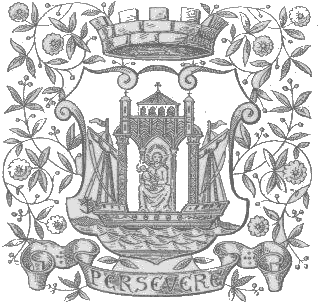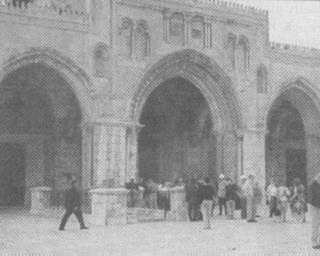|
THE
HISTORY OF LEITH |
||
|
The next time you are in Henderson Street have a look at the Leith Coat of Arms on the side of the Church Halls for South Leith Church. It was originally on the Leith Gas Works, which was in Baltic Street. Around the shield is Indian maize, in agriculture, cereal plant of the tribe Maydeae of the grass family Gramineae, originating in the Americas, and is edible grain.
According to most histories Columbus introduced Maize into Europe after 1492. So why does it appear on the Coat of Arms of Leith? And why does the same plant appear at Roslin Chapel? Have a look at a different style of the Leith Coat Arms. Over the Virgin Mary and child is what looks like four windows. However, look at the picture taken on the Temple Mount in Jerusalem. Suppose they are not windows but arched doorways as shown in the photograph. The Knight Templars built these in the 12th century. Next Question is why is there a St Clair Street, St Clair Avenue, and St Clair Place in Leith? What is the connection between Leith and the St Clair Family of Roslin?
The family originated in Normandy and under David I acquired Roslin. The St Clairs of Roslin from the time of James II till they resigned the Office in the 18th century were the Grand Masters of Masonry in Scotland. In fact at Roslin Chapel there are at least 22 special Masons marks visible on the fabric of the Chapel. It was Sir William St Clair who along with the logans of Leith and Restalrig, accompanied Sir James Douglas in the mission to take the heart of Robert the Bruce to Jerusalem and with whom he perished in battle with the Saracens at Theba in Spain in 1331. Haco, King of Norway in 1379, created Sir Williams Grandson Prince Henry St Clair of Roslin Earl of Orkney a title confirmed by Robert II. He is according to legend credited with the discovery of America a century before Columbus-it may be more than a legend: how would you account for the sculptured maize at Roslin Chapel founded in 1446 almost 50 years before Columbus. It is also interesting to note that a Charter of Bishop Mudy of Caithness to the Preceptory of St Anthony at Leith would only have proceeded on the say so of the Earls of St Clair as they held Caithness as a part of Orkney. Also Gibert Mudy, who is mentioned in the Charter and brother of the Bishop of Caithness, only held the Castles of Scrabster at Thurso and Skibo at Dornoch under the feudal rights of the Earls of Roslin. So why donate a chapel to St Magdalene at Leith outside his sphere of influence when he could set it up at Elgin Cathedral. Which is a lot closer. This in turn, raises the question of why there is a Magdalen Chapel in the Cowgate, and a Magdalen Bridge near musselburgh . Why was St Magdalen so important within the local area? It is said that the coat of arms of Leith is the Virgin Mary and the infant Jesus as St Mary was the patron saint of seamen, which she is not. The patron saint of seamen was St Nicholas and there was a chapel and mediaeval hospice in north Leith, which lead to the foundation of Trinity House in the Kirkgate, Let us speculate. Suppose for arguments sake. Mary Magdalene was the wife of Jesus and she was expecting child. I don’t think she would sit around waiting for the knock on the door. After all she had seen her husband executed. So according to legend she fled to what was to become France with Joseph of Arimathea. The Grail wasn’t a cup but was the unborn child or Sangraal- Blood Royal”. So the Leith Coat of Arms doesn’t in fact show the Virgin marry and Child but St Mary Magdalene and the Child of Jesus. This is confirmed from the earliest of Leith’s Coat of Arms, which shows a one masted ship common in the Mediterranean during the Ist century AD. It represents St Magdalene leaving the Holy Land by boat with the son of Jesus, and this is in line with many legends of the Mediaeval period which were later elaborated on to give us the Grail legends. Eventually that child would marry into the ruling house of France and his descendants would influence the history of France and Europe. This in turn influenced the formation of the Knight Templars and when the French Templars fled to Scotland the secret was brought with them to Roslin. And Leith was dedicated to St Mary Magdalene, not St Mary, as Leith became the Principal Templar Port in Scotland. It was for this reason that Mary of Guise and the French held Leith in 1560 because of its connection to the Templars St Magdalene gave (in her eyes a divine right to rule in Scotland) That is why she died in Edinburgh when she realised she couldn’t win. She just gave up. |
||

